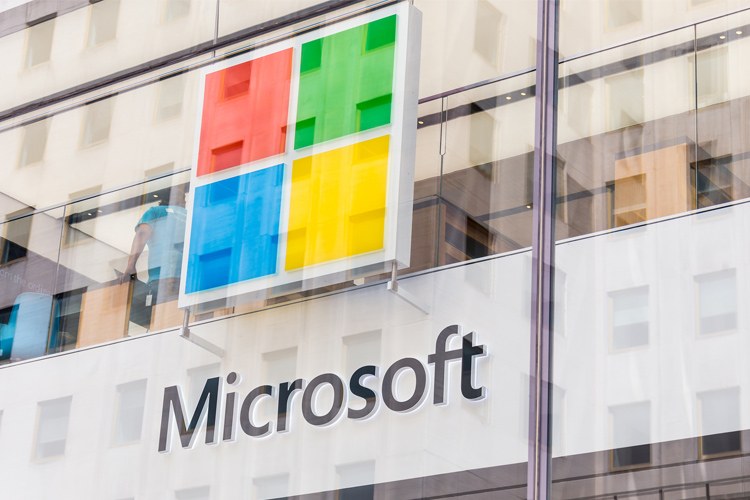Microsoft’s logo has gone through many changes, and each has reflected the shifting priorities of the famous software giant. A rapidly changing industry called for a logo that could keep up with those changes. Here’s a look at the evolution of the company and the logo.

Microsoft’s Early Days
Bill Gates and Paul Allen founded Microsoft in 1976. Famously, they dropped out of Harvard and moved to Albuquerque, New Mexico, to start their new personal computer company.
In 1979, Microsoft moved its headquarters to Bellevue, Washington, where its headquarters are today. By 1983, Microsoft was making more than $50 million in sales.
Disco Fever
Simon Daniels, a staff graphic artist, created Microsoft’s first logo. To do so, he used a programming language that generated lines and circles to create a stylized logo that had a distinctly “disco” look. This was modern for the 1970s, but company executives thought it needed an update as a new decade began.
In the early 1980s, the logo’s font changed from the fun disco stripes to a dark, bold font that looked very dramatic. Daniel designed this logo in 1980, but it only lasted two years. The design may have been interesting from a visual standpoint, but it was a little too abstract and hard to read.
The Blibbet Is Born
In 1982, Microsoft introduced its most famous logo. This was a simple logo that used the word Microsoft in an easy-to-read san serif font. The first “O” in the word, however, had parallel stripes running through it.
This stylized O seized the imagination of Microsoft employees, who named it “the Blibbet.” The Blibbet would become an iconic image to these employees and even members of the public who bought their first personal computers from Microsoft in those years.
A Cult Favorite
The Blibbet became a standalone logo. Microsoft used it on official company stationery, on product boxes and in advertising. Despite its cult status, announced it would change its logo yet again in 1987.
On hearing this, a group of employees launched a “Save the Blibbet” campaign. They signed petitions and made buttons promoting the little round symbol.
Despite their pleas, Microsoft said goodbye to the Blibbet, but the company still serves a commemorative Blibbet Burger in the Microsoft cafeteria.
The Pac-Man Logo
In 1987, in-house designer Scott Baker designed the longest-lasting logo in Microsoft’s history. This was part of an overall rebranding the company went through to position itself for a new era in computing.
Baker said he wanted the new logo to convey speed and to emphasize the word “soft.” The logo no longer used all caps as past logos had. It used a slanted, title case font and featured a slash between the O and the S. This slash looked almost like a bite mark, which led to employees dubbing the logo “the Pac-Man logo.”
The company was obviously happy with it. The Pac-Man logo lasted for over 25 years. Over the years, a few variations appeared. Most of these variations involved unique phrases that would appear under the Microsoft name. One line was, “Your potential. Our passion.” In some advertisements, the words read, “Be what’s next.”
Adding the Windows Logo
In 2012, Microsoft released a new logo that combined its name with a symbol for the first time. The symbol was a set of four colored panes that formed a square. This was clearly a reference to Windows, Microsoft’s famous operating system.
This logo has lasted up to the present with only a few minor changes. In 2015, the typeface on the logo changed to Segoe, which is a Microsoft branded font.
Microsoft has always used a separate logo for its operating system. The Windows logo has a history of its own.
Read more on trademarking your logo.
A Blue Window
In 1985, Microsoft released the Windows operating system with a graphic user interface. This operating system transformed home computing, and Microsoft wanted a logo that would reflect this transformation.
The 1985 logo uses a blue window broken into several panes of varying sizes. This was a modern look for that year, but it looks very dated now.
Changes and New Colors
In 1989, Microsoft redesigned the window logo. It became a sleek, slender window in a monochrome color scheme. Most computers had monochrome screens in the 1980s, and the company wanted something that would look good on all those screens.
The design is classic and timeless. It would probably look good if it were to appear on computer screens now.
In the 1990s, the window logo and typeface both went through a series of changes. Both seemed to change every couple of years. By now, they appeared in full color because most computers could show them in color.
Flying Window
In 1995, the launch of Windows 95 called for a new interpretation of the logo. In this one, the word Microsoft ran parallel to the word Windows. The window took on a curved shape that made it look like it was flying.
The window graphic went through several changes, but most depictions made it look like it was flying or slanted to indicate fast movement.
Why Is It a Flag?
The next major rebranding happened in 2012. Microsoft put together a team that included Microsoft employees, in-house designers and an outside design firm. During an early meeting, one designer asked, “Your name is Windows. Why is your logo a flag?”
The designer, Paula Scher, is a leading graphic design artist who has worked on well-known campaigns for many tech companies and luxury brands. She was referring to the flying window icons, which looked like waving flags.
Scher suggested Microsoft return to the original flat graphic that was recognizable as a window. After the rebranding, Microsoft emerged with a new logo. This used a simple, san serif font and a flat window.
Current Logo
Microsoft still uses this 2012 logo. With a bright blue color, it’s a very appealing logo that conveys precision and simplicity.
Microsoft has come a long way since its early days. Like its logos, the company has shown an ability to change and adapt when necessary.

